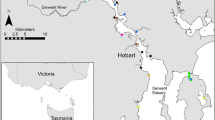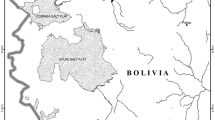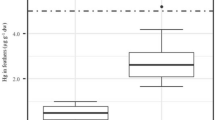Abstract
The levels of heavy metals and selenium in the eggs and in breast feathers of adult doublecrested cormorant (Phalacrocorax auritus), black-crowned night heron (Nycticorax nycticorax), and franklin's gull (Larus pipixcan) nesting at Agassiz National Wildlife Refuge in Marshall County, northwestern Minnesota were examined. Also examined were metal levels in the feathers of fledgling night herons and gulls, in the feathers of adult and fledgling American bittern (Botaurus lentiginosus), in eggs of American coot (Fulica americana) and eared grebe (Podiceps caspicus), and in feathers of adult Canada geese (Branta canadensis). These species represent different levels on the food chain from primarily vegetation-eating species (geese, coot) to species that eat primarily fish (cormorant). A clear, positive relationship between level on the food chain and levels of heavy metals occurred only for mercury in feathers and eggs. Otherwise, eared grebes had the highest levels of all other metals in their eggs compared to the other species. No clear food chain pattern existed for feathers for the other metals. For eggs at Agassiz: 1) lead, selenium, and manganese levels were similar to those reported in the literature, 2) mercury levels were slightly higher for cormorants and night herons, 3) all species had higher chromium and cadmium levels than generally reported, and 4) eared grebes had significantly higher levels of cadmium than reported for any species from elsewhere. For adult feathers: 1) gulls had higher levels of lead than the other species, 2) cadmium levels were elevated in gulls and adult herons and cormorants, 3) mercury levels showed an increase with position on the food chain, 4) selenium and chromium levels of all birds at Agassiz were generally low and 5) manganese levels in adults were generally higher than in the literature for other species. Adults had significantly higher mercury levels than fledgling gulls, night herons, and bitterns.
Similar content being viewed by others
References
Applequist, H., Askirk, S. and Draback, L.: 1984, ‘Mercury monitoring: Mercury stability in bird feathers’, Marine Pollut. Bull. 15, 22–27.
Braune, B. M.: 1987, ‘Comparison of total mercury levels in relation to diet and molt for nine species of marine birds’, Arch. Environ. Contam. Toxicol. 16, 217–224.
Braune, B. M. and Gaskin, D. E.: 1987a, ‘Mercury levels in Bonaparte's Gull (Larus philadelphia) during autumn molt in the Quoddy region, New Brunswick, Canada’, Arch. Environ. Contam. Toxicol. 16, 539–549.
Braune, B. M. and Gaskin, D. E.: 1987b, ‘A mercury budget for the Bonaparte's Gull during autumn moult’, Ornis Scand. 18, 244–250.
Burger, J.: 1974, ‘Breeding adaptations of Franklin's Gulls (Larus pipixcan) to a marsh habitat’, Anim. Behav. 22, 521–567.
Burger, J.: 1994a, ‘Metals in avian feathers: bioindicators of environmental pollution, Rev. Environ. Toxicol. 5, 203–311.
Burger, J.: 1994b ‘Heavy metals in avian eggshells: another excretion method’, J. Toxicol. and Environ. Health 41, 207–220.
Burger, J.: (1995), ‘Heavy metal and selenium concentrations in eggs of Herring Gulls (Larus argentatus): temporal differences from 1989 to 1994’, Arch. Environ. Contam. and Toxicol. 29, 192–197.
Burger, J.: (in press) ‘Heavy metal and selenium levels in Franklin's Gulls in interior North America’, Auk.
Burger, J. and Gochfeld, M.: 1985, ‘Comparisons of nine heavy metals in salt gland and liver of Greater Scaup (Aythya marila), Black Duck (Anas rubripes), and Mallard (A. platyrhynchos)’, Compar. Biochem. Physiol. 81C, 287–292.
Burger, J. and Gochfeld, M.: 1988, ‘Metals in terns eggs in a New Jersey estuary: A decade of change’, Environ. Monitor and Assess 11, 127–135.
Burger, J. and Gochfeld, M.: 1991, ‘Cadmium and lead in Common Terns (Aves: Sterna hirundo): Relationship between levels in parents and eggs’, Environ. Monitor and Assess. 16, 253–258.
Burger, J. and Gochfeld, M.: 1993, ‘Lead and cadmium accumulation in eggs and fledgling seabirds in the New York Bight’, Environ. Toxicol. and Chem. 12, 261–267.
Burger, J. and Gochfeld, M.: 1994, ‘Franklin's Gull (Larus pipixcan), Birds of North America. 116, 1–28.
Burger, J., Nisbet, I. C. T. and Gochfeld, M.: 1992a, ‘Metal levels in regrown feathers: assessment of contamination on the wintering and breeding grounds in the same individuals’, J. Toxicol. and Environ. Health 37, 363–374.
Burger, J., Cooper, K., Saliva, J., Gochfeld, D., Lipsky, D. and Gochfeld, M.: 1992b, ‘Mercury bioaccumulation in organisms from three Puerto Rican estuaries’, Environ. Monitor. Assess. 22, 181–197.
Eisler, R.: 1987, ‘Mercury hazards to fish, wildlife and invertebrates: A synoptic review’, U.S. Department of the Interior, Biological Report 85(1.10), Washington, DC.
EPA: 1992, ‘Framework for ecological risk assessment’, (Environmental Protection Agency) EPA/630/r-92/001 Washington, DC.
Fimreite, N., Brun, E., Froslie, A., Fredericksen, P. and Gundersen, N.: 1974, ‘Mercury in eggs of Norwegian birds’, Astarte 1, 71–75.
Fowler, S. W.: 1990, ‘Critical reviews of selected heavy metal and chlorinated hydrocarbon concentrations in the marine environment’, Marine Environ. Res. 29, 1–64.
Furness, R. W. and Rainbow, P. S. (eds.): 1990, Heavy Metals in the Marine Environment, CRC Press, Boca Raton, Florida.
Glass, G. E., Sorenson, J. A., Schmidt, K. W., RappJr., G. R., Yap, A. and Fraser, D.: 1991, ‘Mercury deposition and sources for the Upper Great Lakes region’, Water, Air, and Soil Pollut. 56, 235–249.
Goede, A. A. and DeBruin, A. A.: 1984, ‘The use of bird feather parts as a monitor for metal pollution’, Environ Pollut. Series B 8, 281–298.
Haseltine, S. D., Heinz, G. H., Reichel, W. I. and Moore, J. F.: 1981, ‘Organochlorine and metal residues in eggs of waterfowl nesting on islands in Lake Michigan off Door County, Wisconsin, 1977–78’, Pesticide Monitor J. 15, 90–97.
Hoffman, D. J., Ohlendorf, H. M. and Aldrich, T. W.: 1988, ‘Selenium teratogenesis in natural populations of aquatic birds in Central California’, Arch. Environ. Contamin. Toxicol. 17, 519–525.
Houghton, J. T., Callander, B. A. and Varney, S. K.: 1992, Climate Change 1992. Cambridge University Press, Cambridge, UK.
Hutchinson, T. C.: 1987, ‘Lead, mercury, cadmium and arsenic in the environment’ (SCOPE Monograph 31), Wiley, Chichester, UK.
Hutton, M.: 1987, ‘Cadmium’, pp. 35–42 in: T. C., Hutchinson and K. M., Meema (eds.), Lead, Mercury, Cadmium and Arsenic in the Environment (SCOPE Monograph 31), Wiley, Chichester, UK.
King, K. A., Lefever, C. A. and Mulhern, B. M.: 1983, ‘Organochlorine and metal levels in Royal Terns nesting on the central Texas coast’, J. Field Ornithol. 54, 295–303.
Leonzio, L. and Massi, A.: 1989, ‘Metal biomonitoring in bird eggs: a critical review’, Bull. Environ. Contam. Toxicol. 402–406.
Lindberg, P. and Odsjo, T.: 1983, ‘Mercury levels in feathers of Peregrine Falcon Falco peregrinus compared with total mercury content in some of its prey species in Sweden’, Environ Pollut. 5, 297–318.
Lewis, S. A. and Furness, R. W.: 1991, ‘Mercury accumulation and excretion in laboratory reared Black-headed Gull (Larus ridibundus) chicks’, Arch. Environ. Contam. Toxicol. 21, 316–320.
Molen, E. J., Vander, A. A., Blok and DeGraff, G. J.: 1982, ‘Winter starvation and mercury intoxication in Grey Herons (Ardea cinerea) in the Netherlands’, Ardea 70, 173–184.
NRC (National Research Council): 1993, Issues in Risk Assessment. National Academy Press, Washington, DC.
Ohlendorf, H.: 1995, ‘Agricultural drainwater effects on wildlife in central California’, pp. 577–584, in: D. J., Hoffman, B. A., Rattner, G. A., BurtonJr. and J., CairnsJr. (eds.), Handbook of Ecotoxicology. Lewis Publishers, Chelsea, Michigan.
Ohlendorf, H., Klass, E. E. and Kaiser, T.: 1978, ‘Environmental pollutants and eggshell thinning in the Black-crowned Night Heron’, pp. 63–82, in: A., Sprunt, J. C., Ogden and S., Winckler (eds.), Wading Birds. National Audobon Society, New York, New York.
Ohlendorf, H. M. and Harrison, C. S.: 1986, ‘Mercury, selenium, cadmium and organochlorines in eggs of three Hawaiian seabird species’, Environ. Pollut. 11B, 169–191.
Osborn, P.: 1979, ‘Seasonal changes in the fat, protein and metal content of the liver of Starling (Sternus vulgaris)’, Environ. Pollut. 19, 145–155.
Palmer, R. S.: 1962, Handbook of North American Birds, Vol. 1: Loons Through Flamingos. Yale University Press, New Haven, Connecticut.
Pattee, O. H.: 1984, ‘Eggshell thickness and reproduction in American kestrels exposed to chronic dietary lead’, Archiv. Environ. Contam. Toxicol. 13, 29–34.
Peakall, D. B.: 1992, Animal Biomarkers as Pollution Indicators. Chapman & Hall, London, UK.
Porcella, D. B.: 1992, ‘Mercury in the environment: biogeochemistry’, pp. 3–10, in: C. J., Watras and J. W., Huckabee (eds.), Mercury Pollution: Integration and Synthesis. Lewis Publishers, Boca Raton, Florida.
Renzoni, A., Focardi, S., Fossi, C., Leonzio, C. and Mayol, J.: 1986, ‘Comparison between concentrations of mercury and other contaminants in eggs and tissues of Cory's Shearwater (Calonectris diomedea) collected on Atlantic and Mediterranean Islands’, Environ. Pollut. 40, 17–35.
Sarkka, J., Hattula, L., Paasivirta, J. and Janatuinen, J.: 1978, ‘Mercury and chlorinated hydrocarbons in the food chain of lake Paijanne, Finland’, Holarctic Ecol. 1, 326–332.
SAS Institute: 1985, SAS User's Guide, 1985 ed. SAS Institute Incorporated, Cary, North Carolina.
Serafin, J. A.: 1984, ‘Avian species differences in the intestinal absorption of xenobiotics (PCB, dieldrin, Hg2+)’, Compar. Biochem. Physiol. 78, 491–496.
Wiemeyer, S. N., Jurek, R. M. and Moore, J. F.: 1986, ‘Environmental contaminants in surrogates, foods, and feathers of California Condors’, (Gymnogyps californianus), Environ. Monitor, and Asses. 6, 91–111.
Zillioux, E. J., Porcella, D. B. and Benoil, J. M.: 1993, ‘Mercury cycling and effects in freshwater wetland ecosystems’, Environ. Toxicol. Chem. 12, 2245–2264.
Author information
Authors and Affiliations
Rights and permissions
About this article
Cite this article
Burger, J., Gochfeld, M. Heavy metal and selenium levels in birds at Agassiz National Wildlife Refuge, Minnesota: Food chain differences. Environ Monit Assess 43, 267–282 (1996). https://doi.org/10.1007/BF00394454
Issue Date:
DOI: https://doi.org/10.1007/BF00394454




